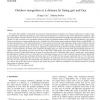Free Online Productivity Tools
i2Speak
i2Symbol
i2OCR
iTex2Img
iWeb2Print
iWeb2Shot
i2Type
iPdf2Split
iPdf2Merge
i2Bopomofo
i2Arabic
i2Style
i2Image
i2PDF
iLatex2Rtf
Sci2ools
144
Voted
IVC
2007
2007
Outdoor recognition at a distance by fusing gait and face
We explore the possibility of using both face and gait in enhancing human recognition at a distance performance in outdoor conditions. Although the individual performance of gait and face based biometrics at a distance under outdoor illumination conditions, walking surface changes, and time variations are poor, we show that recognition performance is significantly enhanced by combination of face and gait. For gait, we present a new recognition scheme that relies on computing distances based on selected, discriminatory, gait stances. Given a gait sequence, covering multiple gait cycles, it identifies the salient stances using a population hidden Markov model (HMM). An averaged representation of the detected silhouettes for these stances are then built using eigenstance shape models. Similarity between two gait sequences is based on the similarities of these averaged representations of the salient stances. This gait recognition strategy, which essentially emphasizes shape over dynamic...
Gait | Gait Sequences | IVC 2006 | IVC 2007 | Multiple Gait Cycles |
Related Content
| Added | 26 Dec 2010 |
| Updated | 26 Dec 2010 |
| Type | Journal |
| Year | 2007 |
| Where | IVC |
| Authors | Zongyi Liu, Sudeep Sarkar |
Comments (0)

